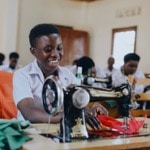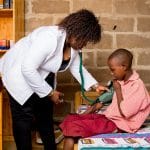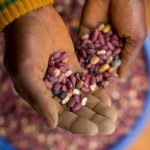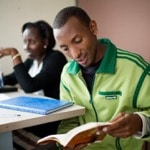The Republic of Rwanda is fondly referred to as “The Land of a Thousand Hills” by its citizens. With a variety of landscapes, Rwanda is lush from the western mountains to the eastern savannah. Situated just south of the equator in East Africa, Rwanda has a temperate climate with two rainy seasons.
In the heart of Africa, Rwanda is landlocked by its four neighboring countries: Uganda, Tanzania, the Democratic Republic of the Congo, and Burundi. The capital city is Kigali, which is centrally located. While Rwanda’s landmass is roughly the size of Massachusetts, Rwanda’s population is among the densest in Africa at almost 12 million. Rwanda has four official languages: Kinyarwanda, French, English, and Swahili.
PRE-COLONIZATION
Many people throughout history have been drawn by its breathtaking scenic beauty, but Rwanda was first settled by the Twa Pygmy people between the 5th and 11th centuries, soon followed by the Hutus. By the beginning of the 14th century, a third ethnic group, the Tutsis, had migrated to Rwanda from the North. In the 16th century, the Tutsi minority had established rule and formed a kingdom, with all groups living in peace and harmony.
COLONIZATION
Like many other African countries, Rwanda’s history is heavily influenced by its experiences with European colonization. Germany was the first European country to colonize Rwanda, but it held a short 24-year rule before the League of Nations reassigned the country to Belgium. Belgium consolidated the countries of Rwanda and Burundi into one territory, but by then the two countries had already developed different political systems. Burundi considered itself a constitutional monarchy, while Rwanda was a republic.
However, Rwanda’s republic was unstable. The Belgians had established an ethnically-based hierarchy that favored Tutsis and discriminated against the Hutus. When Rwanda formally became a republic, there was already growing discontent with the stratification.
INDEPENDENCE
In 1959, a peasant revolt grew to the size of a national revolution for Rwandan independence from colonial powers. Rwanda’s first President, Grégoire Kayibanda, was elected by the Party for Hutu Emancipation. What followed was a swift shift of power to Hutu groups at the local level, and mass violence against Tutsis began. Soon after, Belgium granted Rwanda its independence on July 1, 1962, and the ethnic tensions in Rwanda began coming to a head.
By this time, thousands of Tutsis had fled the country to escape discrimination, and over 150,000 of them began living in neighboring countries as refugees. During this period, over 20,000 Tutsis were killed.
GENOCIDE
Thousands of Tutsis were displaced until the 1990s when the Rwandan government facilitated a large-scale systematic genocide against Tutsis and Hutu moderates in 1994. Government-run radio stations encouraged civilians to pick up arms against their Tutsi neighbors and promised great rewards. Approximately one million people were killed in just three months before the Rwandan Patriotic Front (RPF) captured Kigali and began restoring order.
You can read more about the 1994 Genocide against the Tutsis here.
RECOVERY
The political and legal infrastructure of Rwanda was not prepared to prosecute thousands of genocidaires, many of whom had fled Rwanda after the RPF gained control in Kigali. With international assistance, Rwanda formed gacaca courts, locally-led courts specially designed to judge cases of genocide. These courts operated and dealt with countless genocidaires before they finally closed in 2012.
The military commander of the Rwandan Patriotic Front, Paul Kagame, continues to lead in rebuilding the nation as president of Rwanda. Kagame has held office since 2000.
CONFLICT IN DRC
In the early 2000s, Rwanda was involved in a conflict in Zaire, now the Democratic Republic of Congo (DRC). Rwandan and Ugandan forces deposed Zaire’s former President, drove out extremist Hutu militias, and brought back thousands of Rwandan refugees.
However, the next President of the newly established DRC did not expel the remaining Hutu militias as he had promised, and so Rwanda switched allegiances, joining rebel forces to depose the new President. A peace deal was agreed upon in 2002 when the DRC promised to disarm the remaining Hutu militias and Rwanda promised it would pull out its troops.
Rwanda TODAY
Rwanda’s future is promising and bright. Rwanda has one of the fastest-growing economies in Africa with a real growth rate of 8.6% in 2018. Approximately 75% of the labor force works in the agricultural sector, and agriculture comprises nearly 31% of the GDP in Rwanda.
Over the last couple of decades, Rwanda has climbed the global economic ladder and grown its education system. When the new constitution was passed in 2003, it required that 30% of parliamentary seats be filled by women. Rwanda currently models the greatest representation of women in parliament in the world, at 61%. Rwanda joined the Commonwealth in 2009 and continues to focus on uniting all Rwandans under one national identity while dispelling ethnic hate crimes.
The Rwandan people continue to show great compassion with creativity and make strides in demonstrating Christ’s radical love. Today, 91.5% of Rwanda’s people profess Christianity as their faith. Africa New Life is thrilled to serve in a country that has learned from its history, and that has so much to teach the rest of the world. Even though the people of Rwanda experienced horrific violence in the 20th century, they have provided the world with an example of resilience, grace, and continued healing. Today, Rwanda is among the safest countries in Africa due to its restored peace and security. Genocide memorials in Rwanda exist to remember the tragedy, honor the dead, and educate Rwandans and the world to help prevent future violence.
Want to learn more? See our suggested resources for learning below.
- Queen of Katwe (Biography, Drama, 2017) – Alan Hotchkiss’ Recommendation
- Poverty, Inc. (Documentary, 2016)
- Rising from Ashes (Documentary, 2012) – Team Trip Department Recommendation
- Kinyarwanda (Drama, 2011)
- Earth Made of Glass (Documentary, 2010)
- As We Forgive (Documentary, 2009) – Team Trip Department Recommendation
- Rwanda Rising (Documentary, 2007)
- Beyond the Gates (Drama, 2007)
- Sometimes in April (Drama, 2005)
- Frontline: The Ghosts of Rwanda (Documentary, 2005)
- History Channel: Do Scars Ever Fade? (Documentary, 2004)
- Hotel Rwanda (Drama, 2004) For a different perspective on this Hollywood film, please read Hotel Rwanda: The Surprising True Story and Why It Matters Today by Edouard Kayihura
ABOUT THE GENOCIDE
- Left to Tell: Discovering God Amidst the Rwandan Holocaust by Immaculee Ilibagiza – Team Trip Department Recommendation
- Lead By Faith: Rising from the Ashes of the Rwandan Genocide by Immaculee Llibagiza
- We Wish to Inform You That Tomorrow We Will Be Killed With Our Families: Stories from Rwanda by Philip Gourevitch
- Life Laid Bare: The Survivors in Rwanda Speak by Jean Hatzfeld
- Shake Hands With the Devil: The Failure of Humanity in Rwanda by Romeo Dallaire & Brent Beardsley – Megan Westby’s Recommendation
ABOUT RWANDA
- Rwanda, Inc.: How a Devastated Nation Became an Economic Model for the Developing World by Patricia Crisafulli and Andrea Redmond – Megan Westby’s Recommendation
- A Thousand Hills: Rwanda’s Rebirth and the Man Who Dreamed It by Stephen Kinzer
- Land of a Thousand Hills: My Life in Rwanda by Rosamond Halsey Carr and Ann Howard Halsey
- A Thousand Hills to Heaven: Love, Hope and a Restaurant in Rwanda by Josh Ruxin
- Land of Second Chances: The Impossible Rise of Rwanda’s Cycling Team by Tim Lewis
RELEVANT TOPICS
- When Helping Hurts: How to Alleviate Poverty Without Hurting the Poor and Yourself by Steve Corbett & Brian Fikkert
- Serving with Eyes Wide Open: Doing Short-Term Missions with Cultural Intelligence by David A. Livermore
- Foreign to Familiar: A Guide to Understanding Hot And Cold Climate Cultures by Sarah A. Lanier – Team Trip Department Recommendation
- African Friends and Money Matters by David E. Maranz
- Giving Wisely: Killing with Kindness or Empowering Lasting Transformation by Jonathan Martin
- Overview of When Helping Hurts concepts (6-part series; ~15 minutes each)
- Living Culture Clip, Rwanda
- 2 Part History of Rwanda in the 20th century Part 1; Part 2
- We Need to Learn from Christians from Other Cultures (Blog, June 2017)
- Why you should beware a laughing or yawning hippo (Jan. 2016)
Do not be afraid, just be knowledgeable in the game parks! - Gorillas and Coffee Bars? The Transformation of Rwanda (Sept. 2015)
- An African orphan on what he loves (and doesn’t) about short-term mission teams (May 2014)
- An Op-ed profile of Rwanda’s president Paul Kagame (Sept. 2013)
- Portraits of Reconciliation (April 2014) – Megan Westby’s Recommendation
- High-level overview of the Genocide and its consequences (April 2014)
- Rwanda Vision 20/20 (PDF)
- Constitutional Amendment for Presidential Terms (January 2016)
- BBC President Paul Kagame Profile (January 2016)




